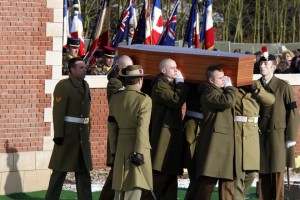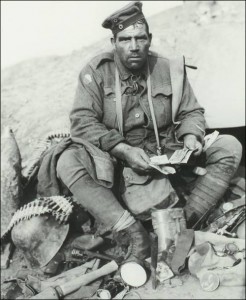 The first of 250 British and Australian soldiers excavated out of 6 World War I mass graves in northern France in 2008 has been reburied with full military honors in a new cemetery built specifically for the fallen of Fromelles.
The first of 250 British and Australian soldiers excavated out of 6 World War I mass graves in northern France in 2008 has been reburied with full military honors in a new cemetery built specifically for the fallen of Fromelles.
On Saturday, in a sombre but moving ceremony, the first of the unidentified soldiers – “known unto God”, as their gravestones are customarily inscribed – was laid to rest in the newly built cemetery 440 yards from Pheasant Wood, the scene of the fiercest fighting.
His oak casket was lowered into the ground by pall bearers from the Royal Regiment of Fusiliers and surrounded by standard bearers from the Royal British Legion. Scores of residents from nearby villages attended the ceremony in the snow-covered graveyard, as well as several Australian families.
As the time-honoured words of the exhortation were read out and Last Post sounded, Kevan Jones, the Veterans Minister, paid tribute to the men who sacrificed their lives. “It was the wish of both the British and Australian governments to give these brave soldiers a fitting place of rest, honouring the commitment shown to our fallen after the First World War,” he said.
Captain Matthew Clarke, officer in charge of the fusiliers, spoke of his deep honour at taking part in the historic task. “We are finally giving these soldiers, who sacrificed everything for our freedom, a fitting military burial,” he said.
This currently unidentified soldier is the first of many to follow. His brothers in arms will be buried at a rate of 30 per day, three times a week over the next month. None of them are identified yet either.
DNA has been collected from all of the recovered bodies and from 150 family members of the thousands who died at Fromelles, so there’s a chance he and his comrades might be identified come Spring. Should that happen, the headstones will be engraved with the proper personal information.
The chances are slim, however. DNA degrades over the years, and the conditions in the mass graves were not exactly laboratory ready. Also, over 7000 soldiers died in the 1916 carnage, so the 150 families who donated their DNA for identification purposes are sadly just the tip of the iceberg.
The identification board will convene in March and to consider the DNA evidence along with any historical, anthropological and archaeological evidence that might serve to identify the deceased. If the soldiers are identified, their families will be given the opportunity to add a personalized inscription to the headstones.
 To catch a glimpse of the lives of these men in the trenches of WWI, see this touching slideshow of some of their personal effects recovered from the mass graves.
To catch a glimpse of the lives of these men in the trenches of WWI, see this touching slideshow of some of their personal effects recovered from the mass graves.
For more about the infamous Australian soldiers who scandalized the British command with their cavalier attitudes toward discipline and impressed/scared the crap out of everyone else with their fierce loyalty and fearless, sometimes brutal fighting, read this outstanding essay from the Heritage of the Great War, the best WWI site on the web, in my opinion.